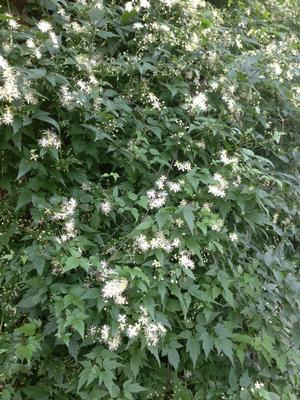New Moon Nurseries
Clematis virginiana
Virgin's bower
Native to North America
FIRST IMPRESSIONS: Clematis virginiana is an attractive native twining vine. Plants have compound leaves with sharply toothed leaflets. In late summer, frothy masses of fragrant white flowers materialize followed by plumed silky seed clusters. This vigorous vine thrives in moist soils in full sun to part shade.
HABITAT & HARDINESS: Clematis virginiana ranges through most of eastern and central North America. Plants occur from Manitoba to Quebec and Nova Scotia and through most of the eastern and central United States.
This vine is indigenous to moist meadows, floodplains, riverbanks, open woods, thickets, ditches, fence rows, roadsides and railroad right of ways. Plants flourish in natural areas or disturbed sites.
Plants are hardy from USDA Zones 3-9.
PLANT DESCRIPTION: Clematis virginiana is a fast growing vine that is supported when stems or petioles twine around vertical supports or nearby plants. If no support is available plants will sprawl on the ground.
Leaves are deciduous in the northern part of the range and semi-evergreen further south. Foliage is opposite and trifoliate. The leaflet margins are cleft or dentate.
In summer the dioecious plants bear either staminate or pistillate flower clusters. Individual blooms are about an inch across with 4 creamy white sepals and no petals. The staminate flowers are reported to be showier than the pistillate blooms.
Flowers mature into masses of silvery plumed seed. The seed clusters consist of several one seeded achenes with slender feathery styles.
Plants grow 20’ tall if suitable vertical support is available.
CULTURAL & MAINTENANCE NEEDS: Clematis virginiana thrives in sun or part shade in rich moist soil or average soil.
In garden situations this vigorous vine may require a sturdy trellis. As an alternative, some gardeners allow the plant to scramble over large established shrubs. Since plants bloom on current season’s stems, excessive growth may be pruned severely during winter without sacrificing the flowers.
Plants can spread aggressively from seed and suckers and careful consideration should be taken before planting this vine in confined spaces.
Leaves contain toxins and are unpalatable to deer and other herbivores.
LANDSCAPE USES: This is a good choice for a Naturalized Area or Wildlife Garden. Clematis virginiana has Fragrance and Showy Blooms and can be used as a Butterfly Nectar Plant, in Deer Resistant Plantings, on Roadsides or Restoration Projects.
COMPANION & UNDERSTUDY PLANTS: Try pairing with Allium cernuum, Rudbeckia laciniata, Rudbeckia triloba, or Tradescantia ohioensis.
Gelsemium sempervirens is a large woody vine that can be planted in similar cultural situations.
TRIVIA: Butterflies and bees sip nectar from the flowers. The lush foliage provides nesting sites for birds and seed heads are desirable nest building materials.
Often confused with the invasive Asian Clematis terniflora or Clematis paniculata. The Asian species have rounded leaves which are usually entire. The native Clematis virginiana has sharply toothed leaves.
Clematis virginiana is reported to cause minor skin irritation.
Like other members of the Buttercup Family, the showy flowers of this clematis actually have no petals. Instead they have colored sepals.
Height:
20 ftSpread:
3-6 ftUSDA Hardiness Zone:
3-9Bloom Color:
WhiteClematis virginiana Characteristics
Attracts Wildlife
- Pollinators
- Butterflies
Attributes
- Naturalizing
- Fragrant
Exposure
- Full Sun to Full Shade
Deer Resistant
- Deer Resistant
Flowering Months
- August
- July
- September
Foliage Color
- Green
Juglans nigra Tolerance (Black Walnut)
- Yes
Soil Moisture Preference
- Moist
